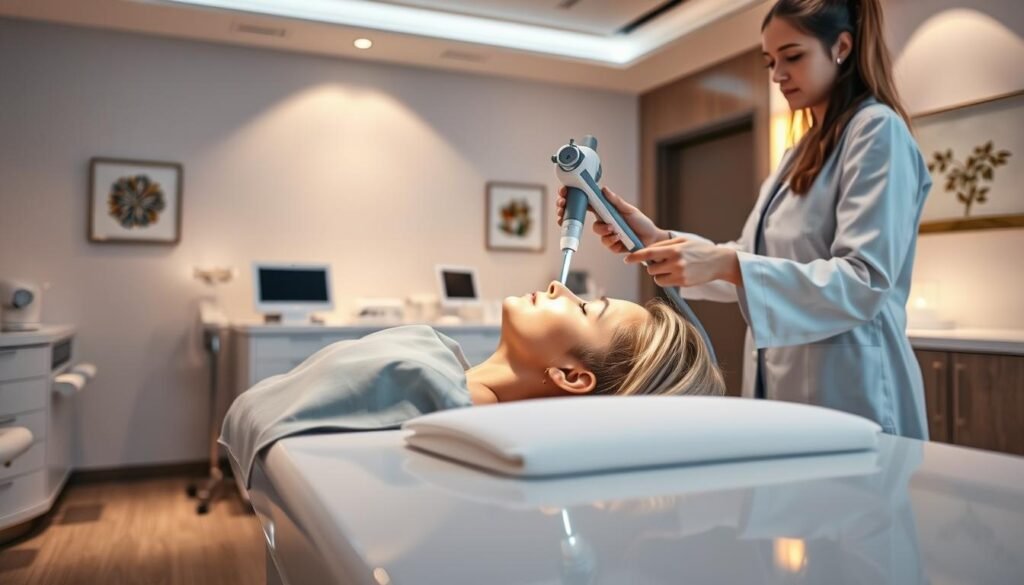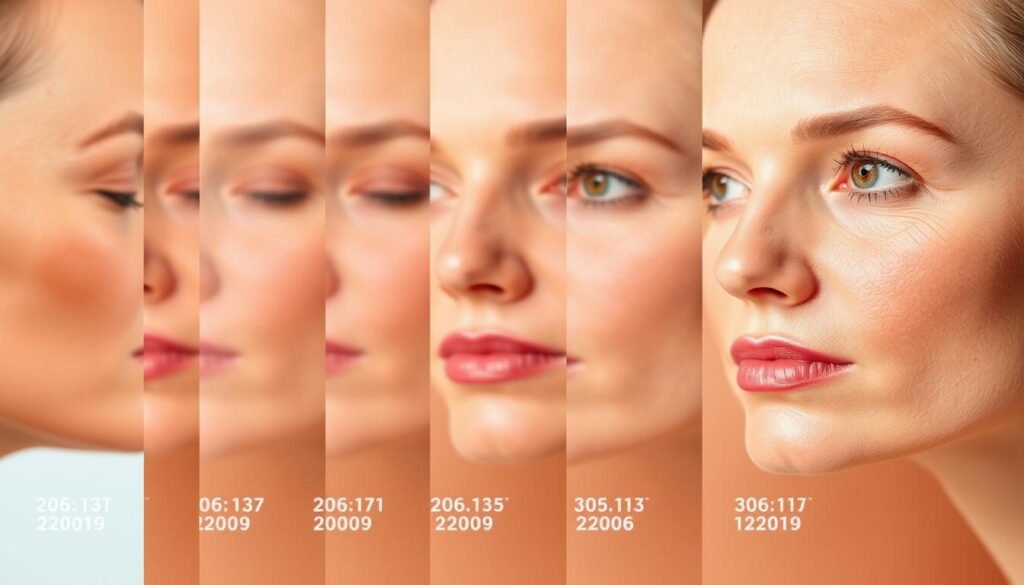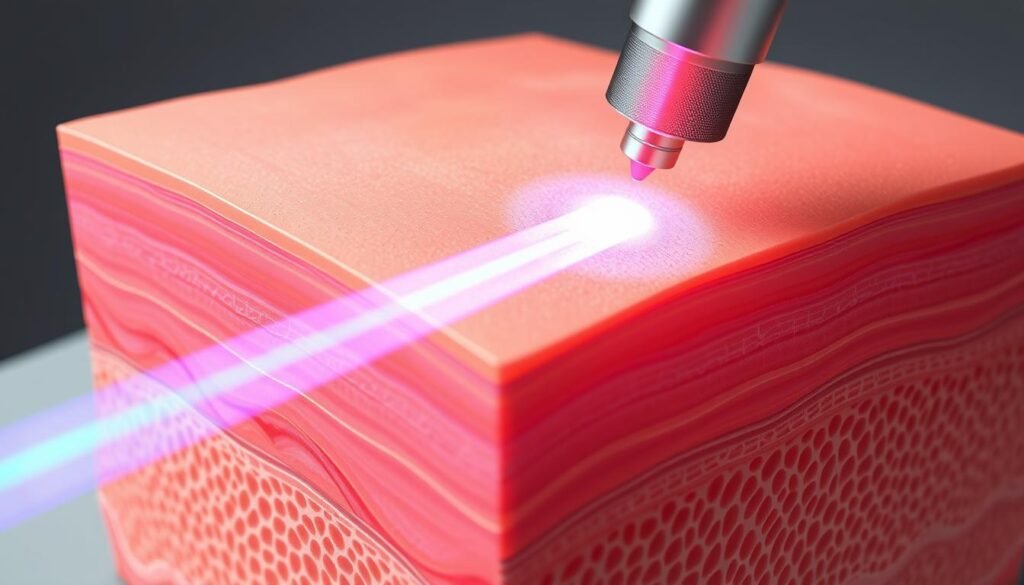Are you tired of dealing with the visible signs of aging on your skin? Laser skin resurfacing is a revolutionary technique that can help you achieve a more youthful and radiant appearance without any incisions.
This non-invasive treatment effectively addresses lines, wrinkles, brown spots, and imperfections, significantly improving the texture and quality of your skin. By leveraging advanced technology, local providers offer various laser technologies and treatment options tailored to different skin types and conditions.
Key Takeaways
- Locate top local providers of laser skin treatment
- Understand how laser skin resurfacing works to rejuvenate your skin
- Explore different types of laser treatments available
- Learn how to research and evaluate the best providers
- Discover the benefits of local laser skin treatment options
Understanding Laser Skin Treatments
Laser skin resurfacing and other laser treatments have emerged as leading solutions for individuals seeking to address skin imperfections and achieve a smoother complexion. These treatments utilize advanced technology to target various skin concerns, ranging from fine lines and wrinkles to significant sun damage and scars.
What Is Laser Skin Resurfacing?
Laser skin resurfacing is a non-surgical procedure that uses laser technology to remove damaged skin layers, promoting collagen production and revealing smoother, healthier-looking skin. This treatment can be tailored to individual skin types and concerns.
Types of Laser Treatments Available
There are several types of laser treatments available, each designed to address specific skin concerns. These include:
- Ablative lasers, such as CO2 and Erbium lasers, which remove outer skin layers to treat deeper wrinkles and significant sun damage.
- Fractional lasers, which treat only a fraction of the skin at a time, creating microscopic treatment zones for faster healing.
- Non-ablative lasers, which work beneath the skin’s surface without removing layers, suitable for mild to moderate skin concerns.
- IPL treatments, which address pigmentation issues and vascular concerns.
The choice between these laser types depends on individual skin types, concerns, and desired results. To better understand the differences, consider the following comparison:
| Laser Type | Description | Ideal For |
|---|---|---|
| Ablative Lasers | Remove outer skin layers completely | Deeper wrinkles, significant sun damage, scars |
| Fractional Lasers | Treat a fraction of the skin at a time | Faster healing, various skin concerns |
| Non-Ablative Lasers | Work beneath the skin’s surface | Mild to moderate skin concerns, minimal downtime |
| IPL Treatments | Address pigmentation and vascular issues | Brown spots, red spots, spider veins |
Benefits of Laser Skin Treatment
Laser skin treatments offer numerous benefits for those seeking to improve their skin’s appearance and address various skin concerns. These treatments are designed to provide effective solutions for a range of skin issues, from fine lines and wrinkles to uneven skin tone and texture.
Addressing Skin Concerns
One of the primary advantages of laser skin treatments is their ability to address specific skin concerns. According to experts, laser energy treatments can significantly improve skin texture and quality. The treatments can help reduce the appearance of fine lines, wrinkles, and scars, resulting in smoother, more even-toned skin.
Long-Term Results and Collagen Production
The benefits of laser skin treatments extend beyond immediate results. The stimulation of collagen production is a significant advantage, as it continues for months after the procedure, providing progressive improvement to skin structure. As a result, patients can expect long-term results, with optimal outcomes typically visible 3-6 months after treatment. This process leads to improved skin firmness, texture, and overall appearance.
As noted by professionals, “The most significant benefit of laser treatments is their ability to stimulate collagen production, which continues for months after the procedure is complete.” This ongoing collagen regeneration process is what sets laser treatments apart from temporary solutions, offering long-lasting results that fundamentally improve skin quality at the cellular level.
Common Skin Conditions Treated with Laser Therapy
Laser therapy has emerged as a versatile solution for various common skin conditions. It works by targeting the root causes of skin issues, providing a more youthful and radiant appearance.
Fine Lines and Wrinkles
Laser skin resurfacing can significantly reduce the appearance of fine lines and wrinkles by stimulating collagen production and promoting smoother skin.
Acne Scars and Sun Damage
Laser treatments are effective in addressing acne scars and sun damage by removing damaged skin cells and promoting new collagen growth, thus improving overall skin texture.
Uneven Skin Tone and Texture
Laser therapy can address uneven skin tone and texture by targeting hyperpigmentation and hypopigmentation, resulting in a more uniform tone and smoother skin surface.
The comprehensive approach of laser therapy not only improves the skin’s appearance but also enhances its natural luminosity and glow. By addressing various skin concerns, individuals can enjoy a more radiant and youthful complexion.
Finding Laser Skin Treatment Near Me
When searching for laser skin treatment options, finding a reliable provider near you is crucial. A successful treatment plan hinges on the expertise of the practitioner and the technology they use.

How to Research Local Providers
To find the best laser skin treatment provider, start by researching local clinics and their reputations. Look for reviews, ask for referrals, and check the qualifications of the practitioners.
Questions to Ask During Consultation
During your consultation, it’s essential to ask the right questions to ensure you’re getting the best treatment for your skin concerns. Ask about the specific type of laser technology recommended for your condition and why it’s the optimal choice. Inquire about the provider’s experience with patients with similar skin types and conditions. Discuss the expected number of treatments needed, potential risks, and the anticipated timeline for seeing improvements. Reviewing before-and-after photos of previous patients can also help you understand the potential outcomes and create a realistic plan.
What to Look for in a Laser Treatment Provider
When searching for a laser treatment provider, it’s crucial to consider several key factors to ensure a safe and effective procedure. The right provider can make a significant difference in the outcome of your laser treatments for various skin concerns.
Credentials and Experience
The credentials and experience of a laser treatment provider are paramount. Look for a provider who has extensive experience in performing laser treatments and has a good reputation. Their expertise will ensure that you receive the best possible care for your skin. A qualified provider will also be able to advise on the most suitable CO2 laser or other laser technologies for your specific needs, potentially avoiding the need for surgery.
Technology and Equipment
We’re very proud to have invested in the technology that enables us to tailor your results to your specific skin type. We offer fully ablative CO2 laser skin resurfacing, fractional ablative CO2 laser skin resurfacing, several different types of Erbium skin resurfacing devices, and non-ablative fractional resurfacing devices.
Some key aspects to consider include:
- State-of-the-art laser equipment that offers better precision, safety features, and customization options.
- Facilities with multiple types of lasers that can better tailor treatments to your specific skin type and concerns.
- Advanced cooling systems integrated into modern laser platforms that enhance comfort during treatment.
- Regular maintenance and calibration protocols for laser equipment to ensure safety and efficacy.
- Providers who invest in the latest FDA-approved laser technology, demonstrating a commitment to offering effective treatment options.

The Laser Skin Treatment Process
To get the most out of your laser skin treatment, it’s essential to know what to expect. The process involves several stages, from preparation to recovery.
Before Your Treatment
Prior to your laser skin resurfacing treatment on your face, you’ll receive written instructions and an educational session to prepare you for the procedure and recovery. This step ensures you’re well-informed about the process.
During the Procedure
The laser treatment process is precise and requires careful execution. Although the specifics can vary, the general procedure involves the use of a laser to resurface the skin.
Post-Treatment Care
After the treatment, your skin will be red and swollen, similar to a sunburn. Proper post-treatment care is crucial for optimal healing over the next few days. For more detailed information on laser skin treatments, you can visit https://trishakhannamd.com/.
Recovery and Results Timeline
Understanding the recovery process and timeline for results is crucial after undergoing laser skin treatment. The recovery period is divided into immediate and long-term phases.
What to Expect in the First Week
In the first week, the treated area may appear red and swollen. This is a normal part of the healing process. Proper post-treatment care is essential to minimize complications and support the healing process.
Long-Term Results and Maintenance
The second phase of healing takes four to six months, during which the body produces new collagen, improving skin strength and elasticity. Results can last for years, but maintenance sessions may be needed annually. Factors like sun exposure and skincare routine affect the longevity of results.
| Timeframe | Healing Phase | Notable Improvements |
|---|---|---|
| 0-1 week | Initial Healing | Redness and swelling |
| 4-6 months | Collagen Production | Skin strength and elasticity improvement |
| 6-12 months | Continued Remodeling | Optimal results visible |

Cost of Laser Skin Treatments
The cost of laser skin treatments can vary significantly based on several factors. Understanding these factors and the available financing options is essential for individuals considering this skincare solution.
Factors Affecting Price
The price of laser skin treatments is influenced by the type of laser used, the size of the treatment area, and the number of sessions required. For instance, treatments for acne scars may require multiple sessions, affecting the overall cost.
Insurance and Financing Options
Most insurance companies regard cosmetic laser treatments as “non-covered” procedures. However, some plans may provide partial coverage for treatments addressing medical conditions. Many providers offer financing options, including third-party financing through companies like CareCredit or Prosper Healthcare Lending, allowing patients to make monthly payments. Additionally, some practices offer in-house payment plans or membership programs that include discounted rates on laser and other aesthetic treatments.
- Health insurance typically does not cover laser skin treatments when performed for cosmetic purposes.
- Some insurance plans may provide partial coverage for treatments addressing medical conditions like acne scarring.
- FSA and HSA funds can sometimes be used for laser treatments, particularly for medical skin conditions.
Comparing Laser Treatments to Other Skin Procedures
Laser skin resurfacing is one of several options for achieving smoother, healthier-looking skin, but how does it stack up against other treatments? When evaluating the best approach for your skin concerns, it’s crucial to understand the differences between laser treatments and other popular skin procedures.
Laser vs. Chemical Peels
Chemical peels and laser skin resurfacing are both effective treatments for rejuvenating the skin, but they work in different ways. Chemical peels involve applying a solution to remove the top layers of the skin, whereas laser skin resurfacing uses laser technology to penetrate deeper into the skin, stimulating collagen production and promoting more significant and longer-lasting results.
A comparison of the two treatments is as follows:
| Treatment | Method | Downtime | Results |
|---|---|---|---|
| Chemical Peels | Applying a chemical solution | Minimal to moderate | Improves skin texture and appearance |
| Laser Skin Resurfacing | Laser technology | Moderate to significant | Stimulates collagen production, significant rejuvenation |
Laser vs. Microdermabrasion
Microdermabrasion is a non-invasive exfoliating treatment that removes the outermost layer of skin, revealing smoother skin. In contrast, laser skin resurfacing can penetrate to varying depths, offering more substantial results. Key differences include:
- Microdermabrasion is a mechanical exfoliation technique that only affects the outermost skin layer, while laser skin resurfacing can penetrate to varying depths for more significant results.
- Laser treatments stimulate collagen production more effectively than microdermabrasion, leading to longer-lasting structural improvements in the skin.
- Microdermabrasion requires virtually no downtime but delivers more subtle results, making it appropriate for maintenance or addressing very minor concerns.
The choice between laser skin resurfacing and microdermabrasion depends on your skin concerns and desired outcomes. For more dramatic rejuvenation, laser treatments may be the preferred option.

Preparing for Your First Laser Treatment Appointment
As you prepare for your first laser treatment appointment, it’s essential to understand the steps you can take to ensure a smooth and successful experience. Proper preparation not only helps in achieving the desired results but also minimizes potential complications.
Pre-Treatment Guidelines
Before your treatment, your provider may give you specific instructions to follow. It’s crucial to adhere to these guidelines to ensure your skin is properly prepared for the laser treatment.
What to Bring to Your Appointment
To make the most of your consultation, come prepared with the following:
- A list of your current medications, supplements, and skincare products.
- Records or before/after photos of any previous cosmetic treatments or surgeries.
- Arrive with a clean face, free of makeup and lotions.
- Consider bringing sunglasses and a hat for sun protection post-treatment.
- Have your payment method and insurance information ready.
Patients receiving sedation will need to arrange for a driver. Schedule your consultation today to take the first step towards achieving your skin goals.
| Pre-Treatment Tips | Description |
|---|---|
| List Medications | Bring a list of all medications and supplements you’re currently taking. |
| Previous Treatments | Share records or photos of previous cosmetic treatments or surgeries. |
| Clean Face | Arrive with a clean face, free of makeup and lotions. |
Conclusion: Taking the Next Step Toward Healthier Skin
By understanding the benefits and processes involved in laser treatments, individuals can make informed decisions about their skin care. The advancements in laser technology have made it possible to address various skin concerns effectively, leading to improved appearance and satisfactory results.
Patient testimonials, such as Sally Jacinkovic’s review on RealSelf, highlight the positive impact of laser skin treatments. With thorough research and consultation with qualified providers, individuals can achieve healthier skin. The technology continues to evolve, offering better outcomes and increased safety.


